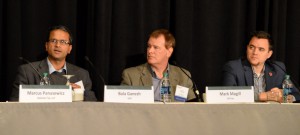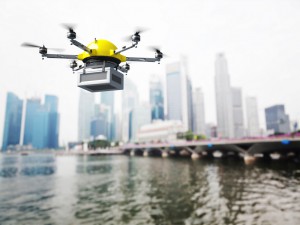Share This
Related Posts
Tags
e-Commerce Delivery
By Erica Rascón on Mar 12, 2015 in News
The NAIOP Commercial Real Estate Development Association recently held its second annual E.Con in Atlanta, a conference dedicated to e-commerce innovation. During the two-day event, last mile delivery stayed at the forefront of conversation. As the nation faces a shortage of 240, 00 0 truck drivers, e-commerce companies are actively seeking alternatives to traditional delivery methods.
0 truck drivers, e-commerce companies are actively seeking alternatives to traditional delivery methods.
Panelists and attendees discussed four current trends:
Unmanned vehicles The lack of CDL drivers and the high costs of employing them are leading e-commerce retailers to seek other ways of getting products from distribution centers to the homes of consumers. Removing drivers altogether could be the solution. That’s one approach that has been tried in Europe and Asia.
Those programs started 10 years ago. Unmanned vehicles still haven’t caught on because studies (and many companies) suggest that automated trucks are most suitable for interstate conditions. The last mile in urban and suburban areas has risks associated with pedestrians, frequent construction and redirects, varying laws, and erratic behavior from human drivers nearby. More research and innovation will be needed to make companies and consumers comfortable with unmanned delivery vehicles in heavily populated areas.
Uber-style delivery systems Independent delivery services are also popping up across the nation. Drivers for hire (those with a standard non-commercial license) can carry out deliveries from urban and suburban distribution centers to doorsteps. They do not require the pay or hours of career truck drivers. Start-ups and smaller e-commerce companies are exploring these options. They may become more prevalent in the future.
There is one major problem. Currently, there is no software that coordinates product size, weight, and shipping distance with these drivers for hire.
Everett Steele, CEO of Kanga says, “There is this idea, ‘I want to be the Uber for delivery,’ but one of the challenges that people underestimate the significance of, in my opinion, is the fact that while Uber is a great service, they understand that no matter who is contacting them, 99.99% of all people on earth will fit in 99.99% of vehicles in existence. Where they go from there doesn’t matter. Last mile delivery is a totally different animal. You may think a sofa is a two-person job but I’m thinking of one of those L-shaped things that take 6 people to move. Linking up those two sizes for delivery is just very challenging. As much as everyone likes the idea of automated delivery, it’s a human, intelligence based problem.”
Drones As fascinating as drones may be, the panelists at NAIOP weren’t convinced that they were a viable solution for last mile deliveries, either.
 Bala Ganesh, Director of Marketing, UPS, explains, “If you’re in an urban area, a drone situation isn’t going to work. It’s more likely to work in rural or suburban areas where you’re less likely to have as many obstructions. On the flip side, in suburban areas, you also have restrictions in when you can fly, especially abroad. There isn’t a single challenge or solution.”
Bala Ganesh, Director of Marketing, UPS, explains, “If you’re in an urban area, a drone situation isn’t going to work. It’s more likely to work in rural or suburban areas where you’re less likely to have as many obstructions. On the flip side, in suburban areas, you also have restrictions in when you can fly, especially abroad. There isn’t a single challenge or solution.”
Expected obstacles such as buildings, power lines, and billboards can be easily avoided using cameras and mapping. In addition to product size and weight variables, unpredictable human obstructions and interference pose the most formidable challenge for drone deliveries in urban areas.
Third-party lockers There is also another option, a bridge between delivery and brick-and-mortar shopping. Some companies are testing the use of secure lockers at third-party stores as a pickup location for deliveries, like your neighborhood Walgreens or CVS. The option appeals to consumers because delivery to the third party store is free (or nominal compared to traditional shipping costs) and the third party location is closer to the consumer’s home than the distribution center. It’s a benefit for the company because packages can hitch a ride on other delivery trucks and minimize the cost of last mile deliveries.
Then there is Doorman, a logistics start-up in San Francisco that acts as a delivery hub. Consumers place an order online, have it sent their “personal Doorman shipping address,” and then Doorman delivers it to their home at their requested time between 6pm to midnight, 7 days a week. Doorman is a consumer-focused product but a similar model could be beneficial for businesses. Consider a co-op distribution center for various e-commerce companies.
This is an exciting and costly time for the industry. The growing popularity of next day delivery presses companies to find fast and inexpensive solutions for shipping. The NAIOP panel concluded that the next five years would be full of exploration and fads. It will be a while before the dust settles and we can induct the new king of last mile delivery.
